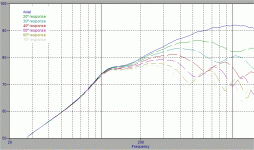The only possible measurements of HOMs in horns I know of were by Jean-Michel Le Cleac'h. If there are others, I don't know of them but would be happy to see them.
Whether or not they exist isn't the most important factor. What is important is are they causing the audible problems ? Or is it something more mundane? It like thinking that premium parts will fix your crossover when it's poorly designed to begin with.
Look for the most obvious reason things aren't sounding good before chasing esoteric details. Chasing HOMs won't be a magic cure for horn honk.
Whether or not they exist isn't the most important factor. What is important is are they causing the audible problems ? Or is it something more mundane? It like thinking that premium parts will fix your crossover when it's poorly designed to begin with.
Look for the most obvious reason things aren't sounding good before chasing esoteric details. Chasing HOMs won't be a magic cure for horn honk.
Part of what keeps the controversy going, IMO, is that people talk of 'reducing HOMs', this is largely a geometrical consideration.. the audibility of this is a complex relationship. There are papers on this.
I chose this simulation because it isolates and exaggerates a case of diffraction (a HOM). How do I know it's diffraction? The shown effect would only make sense if it were the intermingling of two separate sources. When the driver is but one, there must be something happening elsewhere.
This only shows when three dimensional data is available. This is how you can assess a commercial waveguide. If they won't show their polars then you're on your own (but if they do, make sure they haven't smoothed out all the clues, become familiar with what raw plots look like).
We used to talk a lot about the driver/horn interface. If one isn't matched to the other you'll have more HOMs.Bigun said:a parasitic property of horns
Take a look at the polars I posted in this link - Best 8" to 12" driver for 130hz tractrix hornnow exist that didn’t back then
I chose this simulation because it isolates and exaggerates a case of diffraction (a HOM). How do I know it's diffraction? The shown effect would only make sense if it were the intermingling of two separate sources. When the driver is but one, there must be something happening elsewhere.
This only shows when three dimensional data is available. This is how you can assess a commercial waveguide. If they won't show their polars then you're on your own (but if they do, make sure they haven't smoothed out all the clues, become familiar with what raw plots look like).
Attachments
Any suggestions for a well designed horn/waveguide that will mate with the HF206/146 30deg exit angle?
I have sent Faitalpro an email asking what the entry angle on the LTH142 is, but i'm guessing it was designed to mate with the HF140 10deg angle.
The K510 looks to have a wider entry angle, but i can't find the numbers anywhere. Is this considered a well designed waveguide?
I've seen several people recommend the HF146/XT1464-combo, but then again i have also been recommended the 2380 horn.
I have sent Faitalpro an email asking what the entry angle on the LTH142 is, but i'm guessing it was designed to mate with the HF140 10deg angle.
The K510 looks to have a wider entry angle, but i can't find the numbers anywhere. Is this considered a well designed waveguide?
I've seen several people recommend the HF146/XT1464-combo, but then again i have also been recommended the 2380 horn.
I guess Faital measure all their drivers on the LTH 142 whether they match exactly or not. I think the result of the mismatch of the driver exit and horn entry angles between HF146 and XT1464 is a little ragged response around 10 kHz.
Regards
Charles
Regards
Charles
It makes sense that the driver/horn interface would mostly affect the very highest frequencies. The time delay of the diffracted signal would be extremely small. It would surprise me that this is where the most damage can be done.
If a few irregularities at 10khz is the worst I can expect from the theoretically mismatched HF146/XT1464, I think I can live with that. I would expect the poor mouth termination of my current other option k510 would have a bigger effect.
If a few irregularities at 10khz is the worst I can expect from the theoretically mismatched HF146/XT1464, I think I can live with that. I would expect the poor mouth termination of my current other option k510 would have a bigger effect.
In this thread from another forum there are measurements of a HF146 on an XT1464 and also on a SEOS, they were part of the reason why I decided to buy a pair of the HF146 drivers except I bought the R version.
FaitalPRO HF146 | AVS Forum
Have you got measurements of your horn and driver? Seeing those might help.
FaitalPRO HF146 | AVS Forum
Have you got measurements of your horn and driver? Seeing those might help.
You might want to try the old towel around the horn mouth trick. A rounded and soft termination can make an audible difference. It's easy to measure as well.
I've used beach towels, foam, sheepskin, pillows, felt and other various tricks. Mr Iwata used termination slots on his bass horns. It all works and is a subtle improvement.
I've used beach towels, foam, sheepskin, pillows, felt and other various tricks. Mr Iwata used termination slots on his bass horns. It all works and is a subtle improvement.
Member
Joined 2009
Paid Member
You might want to try the old towel around the horn mouth trick. A rounded and soft termination can make an audible difference. It's easy to measure as well.
I've used beach towels, foam, sheepskin, pillows, felt and other various tricks. Mr Iwata used termination slots on his bass horns. It all works and is a subtle improvement.
+1 for the old towel around the mouth trick.
Mouth termination can have a pretty big effect.
Have also found strips and wedges of regular cabinet damping foam running from the center of the mouth's end, straight towards the throat can help. Strips not too wide, and extending maybe up to halfway into the horn. But usually only on the narrower coverage angle, for instance on a 60x40 horn, strips on the top and bottom flares. Easy to do, but usually takes polar measurements to see if it really helps..fwiw
Here's a link to another great horn paper ....scroll all the way down to Fig 44, which shows a classic depiction of HOMs.
https://www.grc.com/acoustics/an-introduction-to-horn-theory.pdf
Member
Joined 2009
Paid Member
I'd really have to dig for pics. But there were some photos in the AVS posts that MArk linked to in post #17 above. Nothing very pretty.
Here's a short thread to ponder ( over at LHF ) that nicely underscores that there's really not much that new under the sun ( for horn edge treatment &/or "foamed horn throats" ).



🙂
🙂
Reply #17 beat me to it. That is the single best explanation I've read about many factors affecting horn sound, especially the towel trick. I accept the possibility of HOMs but these are addressed (preferably) by buying one of Geddes' speakers* 🙂 With my curernt horns, I've tried variations of stuffing and lining the waveguide. It has a permanent towel cowl on each waveguide. Other than obvious HF attenuation (when there is batting or other matrial stuffing the waveguide) I've never heard a difference. Nor have I measured one. Lacking knowledge of higher maths, I easily accept the intuitive and experimental arguments that temporal distortions often exist, whether the single-ended open pipe resonance of a poorly terminated mouth (no towel) or longer paths the HOM waves traverse, relative to direct sounds. Whether and how audible these factors are is open to question. But the mods are so easy and cheap that you should try them. Often it's claimed they are only heard at higher output levels. As the user of a pair of "domesticated" PA tops in a normal living room, I have never pushed my speakers too hard as I typically don't listen at 120 dB 😀
*Two required for stereo.
*Two required for stereo.
Last edited:
why is ‘too loud’ an issue for a horn - or do you mean it’s driver distortion from being abused?
Throat distortion, i.e. down where it meets the phase plug; somewhat like happens when you try to flow too much water through a straw, it basically vapor? [hydraulic?] locks, which when combined with strong reflections back to the throat from the mouth increasingly modulating the driver [water 'hammer' effect] and the whole system goes out of whack, so most times it can be cured by proper mouth design/damping, or like a port, 'stick a sock in it', so to speak, i.e. denser foam version of Dr. Geddes' WG 'plug'.
Removing an Altec's bug screen can sometimes be sufficient, so maybe for others too.
GM
The OP should try an original JBL 2380 instead of the PH-2380. I’ve used at least one replica of the JBL original and it is nowhwre close to the same geometry of the original.
Also, the JBL 2380 with a JBL2445 or 46 driver is a match made in heaven. The sound is completely free of the speakers with imaging to die for. As for honk and other bad sound, get the crossover right and get the response flat. That takes care of 99.9% of issues.
I also tried the bms4590 on the jbl 2380 and it sounded awful. Yes, I checked the crossover. And after using the usual fir correction. The tonal balance is there but the music has no impact. So, there is something to be said about matching a driver to the horn.
Also, the JBL 2380 with a JBL2445 or 46 driver is a match made in heaven. The sound is completely free of the speakers with imaging to die for. As for honk and other bad sound, get the crossover right and get the response flat. That takes care of 99.9% of issues.
I also tried the bms4590 on the jbl 2380 and it sounded awful. Yes, I checked the crossover. And after using the usual fir correction. The tonal balance is there but the music has no impact. So, there is something to be said about matching a driver to the horn.
Yes, very good! Still digesting it. Correlates I think to an article in Speaker Builder long ago about cepstral analysis...they were feeling horn sound quality was related to time-delayed energy coming out of the horns. And I've long felt that the "choppiness" of a horn's frequency response is part of all that, that smoother is better:I've always liked this guys definition of horn honk...
scroll down till you see it...good stuff in the thread
Factors Affecting Sonic Quality of Mid & HF Horns & Waveguides
- Actually in general, not just horns
- But you gotta watch out for measurement tricks like smoothing
- Measurement problems like reflections within the measurement window, off the measurement baffle/clamps, microphone and mounting thereof.
- In the case of horns, what the heck baffle you're measuring it on
- Home
- Loudspeakers
- Multi-Way
- Need help from believers in horn HOMs

